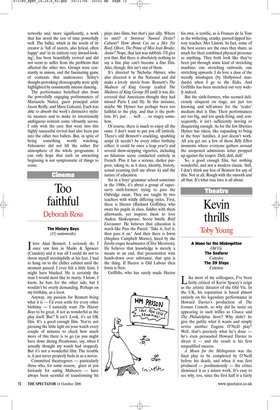Soggy in the corps
Giannandrea Poesio
Triple Bill
Royal Ballet
There are many different ways to start a ballet season, but an artistically disjointed triple bill is not the ideal one. Even on paper the Royal Ballet’s opening programme for 2006/7 looks awkward, and the rationale behind joining Balanchine’s Violin Concerto (1972), Jirí Kyliàn’s Sinfonietta (1978) and Glen Tetley’s Voluntaries (1973) remains unclear. Little matters if each work boasts an important, non-dance-specific score — something that prompted the most welcome presence of Antonio Pappano in the pit. And little matters when each of the three works represents a significant moment in late 20thcentury ballet history. But to come across as successfully woven, a mixed programme requires much stronger artistic, cultural and stylistic links.
Indeed, things would have probably looked better had the dancing not been weak on the night I went. Balanchine’s Violin Concerto is, arguably, the epitome of translating music into choreography — for which Balanchine remains unsurpassed. As such, the ballet requires clockwork perfection, for any discrepancy between danced action and musical execution seriously vitiates its sheer beauty. Alas, last Saturday, discrepancies abounded. Entrances were not always calibrated, lines were not pure, and the overall impression was of a tiresome, uninspired and overcautious approach to the choreographic demands. Although Zenaida Yanowsky, one of the few Royal ballerinas who seems to have a deep understanding of Balanchine’s work, and American-born and trained Alexandra Ansanelli, who is more than familiar with the Balanchine tradition, provided some moments of splendid dancing, they, too, did not look fully attuned to the modernist vibrancy of the dance. Problems were most evident in the corps, for it was their rather soggy and stylistically inconsistent dancing that toned down the whole performance.
Balanchine’s choreography, and that of Violin Concerto in particular, only comes fully to life when, and if, the dancers tackle it with a fast-paced, sparkling, caution-tothe-wind response. Which was not the case at the performance I saw, despite Pappano’s incandescent rendition of Stravinsky’s score, splendidly led by Vasko Vassiliev’s violin.
Lack of interpretative generosity was also evident in the last item on the programme, Kyliàn’s Sinfonietta. Originally conceived as a tribute to a by then politically oppressed land, and set to music by Janacek, the work stands out for the apparently seamless movement ideas. The spacious, aerial use of movements that cover the stage from angle to angle can only be appreciated in full when the performers leave behind any technical constraint and let themselves go. Although all the steps were competently performed, there was little or no choreographic abandon in the performance I saw.
In the opening section, one of the most visually striking in modern ballet history, what should have been a breathtaking flux of soaring dancers became a rather turgid series of miscalculated entrances and notso-exciting jumps. Later on, there was hardly a dancing body that engaged fully with Kyliàn’s modernist take on ballet, and most artists looked incapable of stepping into a movement vocabulary that goes far and freely beyond the strict parameters of classical ballet.
Luckily, stylistic consistency and good dancing were the two winning ingredients of the middle item, Tetley’s Voluntaries. Set to Poulenc’s ever so popular Organ Concerto, the ballet is one of Tetley’s mas terworks and, more significantly, a work that has stood the test of time powerfully well. The ballet, which in the words of its creator is ‘full of secrets, also lyrical, often happy’ and ‘in its entirety very inward-looking’, has been beautifully revived and did not seem to suffer from the problems that affected the other two. Groups were constantly in unison, and the fascinating game of contrasts that underscores Tetley’s thought-provoking choreography were aptly highlighted by consistently intense dancing.
The performance benefited also from the powerfully engaging performances of Marianela Nuflez, guest principal artist Jason Reilly, and Mara Galeazzi. Each was able to absorb the work’s distinctive stylistic nuances and to make its intentionally ambiguous content come vibrantly across. I only wish the care that went into this highly successful revival had also been put into the other two ballets. But, in spite of being something worth watching, Voluntaries did not lift the rather flat atmosphere of the whole programme. I can only hope that such an unexciting beginning is not symptomatic of things to come.



































































































 Previous page
Previous page